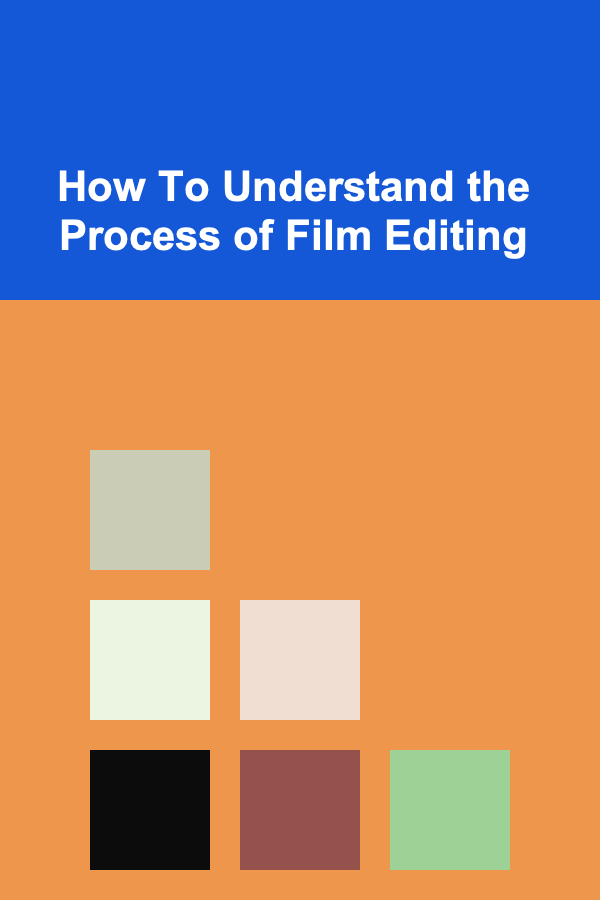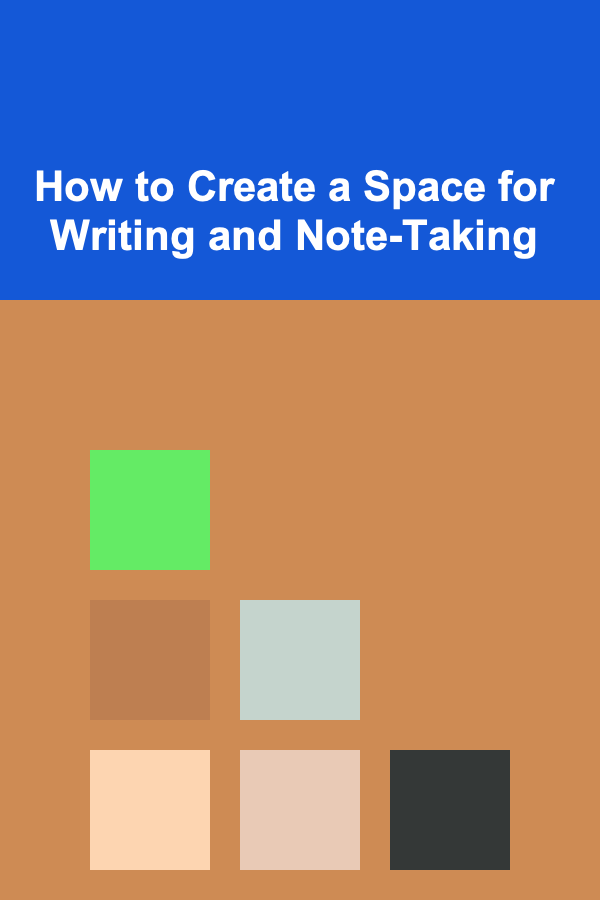
How To Understand the Process of Film Editing
ebook include PDF & Audio bundle (Micro Guide)
$12.99$7.99
Limited Time Offer! Order within the next:

Film editing is one of the most essential aspects of filmmaking. It's the process that transforms raw footage into a cohesive, compelling narrative. Though often invisible to the audience, it plays a critical role in shaping the final film. While directors and actors are often the faces of a film, editors are the invisible architects behind the scenes. In this article, we will break down the film editing process in detail, exploring its key components, techniques, and how it contributes to storytelling.
What is Film Editing?
Film editing is the process of selecting, arranging, and manipulating footage to create a final product. It's often described as the "invisible art" because, when done right, the audience may not even notice it. The primary goal of editing is to arrange the shots in such a way that the story flows seamlessly, maintains audience engagement, and elicits the right emotional responses.
At its core, editing is about making decisions. Editors decide what the audience sees and when they see it, as well as how a scene unfolds. They control the pacing, tone, and rhythm of the narrative. This creative control over time and space allows the editor to manipulate the way a story is told.
The Role of an Editor in Filmmaking
The film editor's role goes far beyond simply splicing together scenes. They collaborate with the director and other members of the production team to bring the director's vision to life. The editor's primary task is to ensure that the raw footage aligns with the narrative structure, pacing, and emotional tone that the director has envisioned.
The editor is also responsible for:
- Choosing shots: Editors decide which takes and scenes will make it into the final cut.
- Pacing and rhythm: Editors create the tempo of a scene by determining the timing between shots.
- Continuity: Editors ensure that the visual flow of the film is consistent, and the story remains coherent.
- Sound integration: Sound is crucial in film editing, and editors often work with sound designers to synchronize audio with the footage, adjust levels, and create sound effects.
Overall, editing can be seen as a collaborative art form, where the editor works to enhance the director's vision and bring it to its fullest expression.
Types of Film Editing
There are several types of film editing, each serving a unique purpose and contributing to the overall film in different ways. Let's explore some of the main types of editing commonly used in film production.
1. Linear Editing
Linear editing is the traditional form of film editing where footage is arranged in a sequential, linear order. The process involves manually cutting and joining film strips, which is why it's called "linear." Although digital technology has replaced physical film editing, the concept of linear editing is still used when editing a film's narrative.
Linear editing has the advantage of simplicity and clarity, as it follows the natural progression of the story. However, it can be restrictive when it comes to experimenting with different structures or jumping between non-linear timelines.
2. Non-linear Editing
Non-linear editing (NLE) is the more common and advanced form of editing used in modern filmmaking. NLE uses computer software such as Adobe Premiere Pro, Final Cut Pro, or Avid Media Composer, which allows editors to access any part of the footage at any time. The advantage of non-linear editing is that it provides greater flexibility, allowing editors to manipulate footage freely and rearrange scenes without affecting the original footage.
With NLE, editors can easily explore multiple versions of scenes and choose the best possible arrangement. They can also make adjustments to pacing, rhythm, and structure more efficiently than in linear editing.
3. Montage Editing
A montage is a type of film editing technique where a series of short shots are edited together to convey a larger idea, passage of time, or emotional transformation. The idea is to create meaning through the juxtaposition of different images and scenes. Montage is often used in films to show the passage of time, character development, or to convey symbolic meaning.
A famous example of montage editing is the "training montage" in sports films, where a series of shots is used to show a character improving their skills. The montage's purpose is to create a sense of progression and emotional payoff without requiring a detailed, linear sequence of events.
4. Parallel Editing (Cross-Cutting)
Parallel editing, or cross-cutting, is a technique used to show two or more events happening simultaneously but in different locations. The editor alternates between these different storylines to create tension, build suspense, or emphasize their connection. This technique is frequently used in thrillers, action films, and dramas.
One classic example of parallel editing is in D.W. Griffith's Intolerance (1916), where the editor intercuts between several stories, all building to a final climactic moment. Parallel editing keeps the audience on edge by showing different perspectives that are eventually linked together.
5. Match Cut
A match cut is a film editing technique where two shots are linked together by similar visual or thematic elements. The cut can happen in the middle of a movement or transition, creating a smooth and often surprising connection between the two scenes.
One of the most famous examples of a match cut is from Stanley Kubrick's 2001: A Space Odyssey (1968), where a bone thrown into the air by a prehistoric ape dissolves into a space station in the future. This cut helps establish a visual and thematic continuity, linking the ancient past to a futuristic present.
The Steps of Film Editing
Film editing is a multi-step process that requires precision and creativity. Below is a breakdown of the general steps involved in editing a film:
1. Pre-Editing: Organization and Planning
Before any actual editing begins, there is a crucial stage of pre-editing. During this phase, the editor works with the director to review the raw footage and determine how the film will be structured. This involves:
- Logging footage: The editor or assistant editor reviews all the footage, marking out important shots and moments that are worth using in the final film.
- Organizing files: The footage is organized by scenes, takes, and other metadata to ensure easy access during the editing process.
- Rough cut: The editor may create a rough cut, which is an initial version of the film that gives a sense of the story and pacing but doesn't yet include all the fine details.
2. Assembly Cut
The assembly cut is where the editor starts to build the film. Using the best takes of each scene, the editor assembles them in the approximate order dictated by the script or director's vision. At this stage, there is no fine-tuning of pacing or rhythm. The assembly cut serves as a blueprint for the film.
3. Fine Cut
Once the assembly cut is completed, the editor moves on to creating the fine cut. This involves making more precise decisions about timing, shot transitions, and pacing. The goal of the fine cut is to create a more polished version of the film that closely resembles the final product.
4. Final Cut
The final cut is the last stage in the editing process, where the film is locked and cannot be altered. During this stage, the editor focuses on small details, such as:
- Adjusting sound levels and effects.
- Perfecting color grading.
- Making final tweaks to transitions and rhythm.
Once the final cut is completed, the film is ready for distribution or post-production processes like sound design, visual effects, and marketing.
The Impact of Editing on Storytelling
Editing has a profound impact on how a film is experienced by the audience. The editor's choices influence everything from pacing to mood to the overall emotional impact of the film. Let's explore how editing can shape storytelling in different ways:
1. Pacing
The speed at which a story unfolds is often dictated by editing. Slow-paced films tend to linger on individual shots, allowing moments to breathe and giving the audience time to absorb the atmosphere. Fast-paced films, on the other hand, may rely on rapid cuts to keep the energy high and maintain tension.
Pacing is also influenced by how long a shot lasts before it is cut to the next. A quick cut between shots can create urgency, while a longer shot can emphasize the importance of a particular moment. Editors manipulate pacing to guide the emotional journey of the audience, and they often use pacing to control tension, surprise, and resolution.
2. Emotional Impact
The emotional tone of a film is often established and maintained through editing. A well-timed cut can heighten emotional beats, while improper pacing can dilute the emotional weight of a scene. Editors can enhance a film's emotional impact by manipulating the rhythm of the cuts, the duration of shots, and the interplay between sound and visuals.
3. Building Suspense and Tension
Suspense and tension are often built through the editor's ability to delay or withhold information. By using techniques like parallel editing, jump cuts, or withholding a key piece of information until the final moment, editors can keep the audience on edge and create a more intense cinematic experience.
4. Narrative Structure
Editing shapes the structure of a story. Films can follow a linear progression, or they can jump back and forth in time through non-linear editing. Flashbacks, flash-forwards, and parallel storylines are all made possible through editing. The structure of the narrative can be manipulated to reveal or conceal information, surprise the audience, or provide deeper insights into characters.
Conclusion
Film editing is a powerful and nuanced process that is fundamental to creating a compelling cinematic experience. It involves much more than simply piecing together raw footage; it is about crafting the rhythm, pacing, and emotional tone of the story. Editing shapes how the audience perceives and engages with the narrative, and it can transform a mediocre film into a masterpiece. Understanding the process of film editing is key to appreciating the art of filmmaking and the collaborative efforts behind the scenes that bring a film to life.

How to Budget for Unexpected Home Emergencies
Read More
How to Create a Space for Writing and Note-Taking
Read More
How to Create More Space in Your Bedroom with Simple Hacks
Read More
How To Support Employee Wellbeing in a Remote Setup
Read More
How to Use Transparent Containers for Organizing Small Items
Read More
How to Prepare Your Home for a Move-Out Checklist
Read MoreOther Products

How to Budget for Unexpected Home Emergencies
Read More
How to Create a Space for Writing and Note-Taking
Read More
How to Create More Space in Your Bedroom with Simple Hacks
Read More
How To Support Employee Wellbeing in a Remote Setup
Read More
How to Use Transparent Containers for Organizing Small Items
Read More